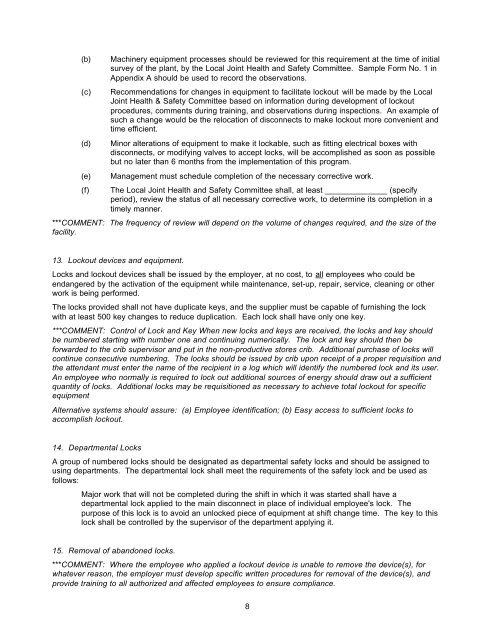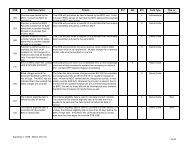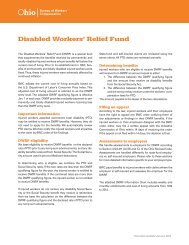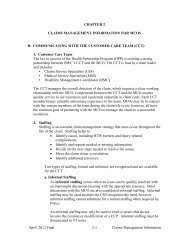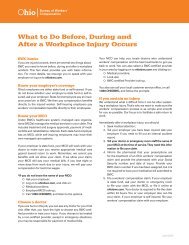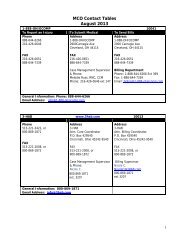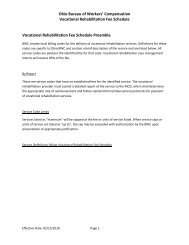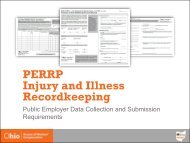Lockout / Tagout - Ohio Bureau of Workers' Compensation
Lockout / Tagout - Ohio Bureau of Workers' Compensation
Lockout / Tagout - Ohio Bureau of Workers' Compensation
You also want an ePaper? Increase the reach of your titles
YUMPU automatically turns print PDFs into web optimized ePapers that Google loves.
(b)<br />
(c)<br />
(d)<br />
(e)<br />
(f)<br />
Machinery equipment processes should be reviewed for this requirement at the time <strong>of</strong> initial<br />
survey <strong>of</strong> the plant, by the Local Joint Health and Safety Committee. Sample Form No. 1 in<br />
Appendix A should be used to record the observations.<br />
Recommendations for changes in equipment to facilitate lockout will be made by the Local<br />
Joint Health & Safety Committee based on information during development <strong>of</strong> lockout<br />
procedures, comments during training, and observations during inspections. An example <strong>of</strong><br />
such a change would be the relocation <strong>of</strong> disconnects to make lockout more convenient and<br />
time efficient.<br />
Minor alterations <strong>of</strong> equipment to make it lockable, such as fitting electrical boxes with<br />
disconnects, or modifying valves to accept locks, will be accomplished as soon as possible<br />
but no later than 6 months from the implementation <strong>of</strong> this program.<br />
Management must schedule completion <strong>of</strong> the necessary corrective work.<br />
The Local Joint Health and Safety Committee shall, at least ______________ (specify<br />
period), review the status <strong>of</strong> all necessary corrective work, to determine its completion in a<br />
timely manner.<br />
***COMMENT: The frequency <strong>of</strong> review will depend on the volume <strong>of</strong> changes required, and the size <strong>of</strong> the<br />
facility.<br />
13. <strong>Lockout</strong> devices and equipment.<br />
Locks and lockout devices shall be issued by the employer, at no cost, to all employees who could be<br />
endangered by the activation <strong>of</strong> the equipment while maintenance, set-up, repair, service, cleaning or other<br />
work is being performed.<br />
The locks provided shall not have duplicate keys, and the supplier must be capable <strong>of</strong> furnishing the lock<br />
with at least 500 key changes to reduce duplication. Each lock shall have only one key.<br />
***COMMENT: Control <strong>of</strong> Lock and Key When new locks and keys are received, the locks and key should<br />
be numbered starting with number one and continuing numerically. The lock and key should then be<br />
forwarded to the crib supervisor and put in the non-productive stores crib. Additional purchase <strong>of</strong> locks will<br />
continue consecutive numbering. The locks should be issued by crib upon receipt <strong>of</strong> a proper requisition and<br />
the attendant must enter the name <strong>of</strong> the recipient in a log which will identify the numbered lock and its user.<br />
An employee who normally is required to lock out additional sources <strong>of</strong> energy should draw out a sufficient<br />
quantity <strong>of</strong> locks. Additional locks may be requisitioned as necessary to achieve total lockout for specific<br />
equipment<br />
Alternative systems should assure: (a) Employee identification; (b) Easy access to sufficient locks to<br />
accomplish lockout.<br />
14. Departmental Locks<br />
A group <strong>of</strong> numbered locks should be designated as departmental safety locks and should be assigned to<br />
using departments. The departmental lock shall meet the requirements <strong>of</strong> the safety lock and be used as<br />
follows:<br />
Major work that will not be completed during the shift in which it was started shall have a<br />
departmental lock applied to the main disconnect in place <strong>of</strong> individual employee's lock. The<br />
purpose <strong>of</strong> this lock is to avoid an unlocked piece <strong>of</strong> equipment at shift change time. The key to this<br />
lock shall be controlled by the supervisor <strong>of</strong> the department applying it.<br />
15. Removal <strong>of</strong> abandoned locks.<br />
***COMMENT: Where the employee who applied a lockout device is unable to remove the device(s), for<br />
whatever reason, the employer must develop specific written procedures for removal <strong>of</strong> the device(s), and<br />
provide training to all authorized and affected employees to ensure compliance.<br />
8


